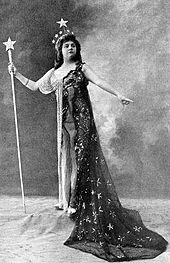- Der Hölle Rache kocht in meinem Herzen
-
"Der Hölle Rache kocht in meinem Herzen" ("Hell's vengeance boils in my heart") is the second aria sung by a coloratura soprano role Queen of the Night in Mozart's opera The Magic Flute (Die Zauberflöte).
Contents
The aria
 Beginning of the first coloratura passage
Beginning of the first coloratura passage
"Der Hölle Rache kocht in meinem Herzen", commonly abbreviated "der Hölle Rache", is often referred to as "the Queen of the Night Aria", despite the fact that the Queen of the Night character sings another distinguished aria earlier in the opera, "O zittre nicht, mein lieber Sohn". It is considered to be one of the most famous opera arias, highly memorable, fast paced and menacingly grandiose.
The aria forms part of the second act of the opera. It depicts a fit of vengeful rage, in which the Queen of the Night puts a knife into the hand of her daughter Pamina and exhorts her to assassinate Sarastro, the Queen's rival, on pain of denying and cursing Pamina if she does not comply.
Music
The aria is written in D minor, and is scored for pairs of flutes, oboes, bassoons, horns, and trumpets, along with timpani and the string section. This is a larger orchestra than for "O zittre nicht" and comprises all the players from the opera as a whole, except the clarinets and trombones.
The aria is widely renowned for being a demanding piece to perform well. The aria's range is two octaves, from F4 to F6 and requires a very high tessitura.
Lyrics
The words were written (in German) by Mozart's friend Emanuel Schikaneder, who also played Papageno in the first performances.
Der Hölle Rache kocht in meinem Herzen,
Tod und Verzweiflung flammet um mich her!
fühlt nicht durch dich Sarastro Todesschmerzen,
so bist du meine Tochter nimmermehr.
Verstoßen sei auf ewig,
verlassen sei auf ewig,
zertrümmert sei'n auf ewig
alle Bande der Natur
wenn nicht durch dich Sarastro wird erblassen!
Hört, Rachegötter, hört der Mutter Schwur!Hell's vengeance boils in my heart;
Death and despair blaze around me!
If Sarastro does not feel the pain of death because of you,
Then you will be my daughter nevermore.
Disowned be forever,
Forsaken be forever,
Shattered be forever
All the bonds of nature
If Sarastro does not turn pale [in death] because of you!
Hear, gods of vengeance, hear the mother's oath!Metrically, the text consists of a quatrain in iambic pentameter (exceptional for this opera, which is mostly in iambic tetrameter), followed by a quatrain in iambic trimeter, then a final pentameter couplet. The rhyme scheme is [ABAB][CCCD][ED].
Performance history
The first singer to perform the aria onstage was Mozart's sister-in-law Josepha Hofer, who at the time was 33. By all accounts, Hofer had an extraordinary upper register and an agile voice and apparently Mozart, being familiar with Hofer's vocal ability, wrote the two blockbuster arias to showcase it.
An anecdote from Mozart's time suggests that the composer himself was very impressed with his sister-in-law's performance. The story comes from an 1840 letter from composer Ignaz von Seyfried, and relates an event from the last night of Mozart's life—December 4, 1791, five weeks into the opera's initial (very successful) run. According to Seyfried, the dying Mozart whispered the following to his wife Constanze:
- "Quiet, quiet! Hofer is just taking her top F; – now my sister-in-law is singing her second aria, 'Der Hölle Rache'; how strongly she strikes and holds the B-flat: 'Hört! hört! hört! der Mutter Schwur!'".[1]
In modern times a great number of notable sopranos have performed or recorded the aria. June Anderson sings it in the film Amadeus. The aria was also a favorite of the famously incompetent singer Florence Foster Jenkins.
A recording of the aria by Edda Moser, accompanied by the Bavarian State Opera under the baton of Wolfgang Sawallisch, is included in a collection of music from Earth on the Voyager 1 spacecraft.
Notes
- ^ Quoted from Deutsch (1965, 556). The B-flat to which Mozart referred is a long, powerful note, sung on the third repetition of "Hört!," to an unexpected Neapolitan harmony in the orchestra and forming the climax of the aria. The original German reads: "Still, still! Jetzt nimmt die Hofer das hohe F; – jetzt singt die Schwägerin ihre zweite Arie: 'Der Hölle Rache'; wie kräftig sie das B anschlägt und aushält: 'Hört! hört! hört! der Mutter Schwur!'". Source: "Die Verdienste des Herrn Schikaneder", Hamburger Abendblatt (3 January 1994) (German)
References
- Deutsch, Otto Erich (1965) Mozart: A Documentary Biography. Stanford University Press.
External links
- Der Hölle Rache kocht in meinem Herzen: Score in the Neue Mozart-Ausgabe
Categories:- Arias by Wolfgang Amadeus Mozart
- Opera excerpts
- 1791 works
Wikimedia Foundation. 2010.

